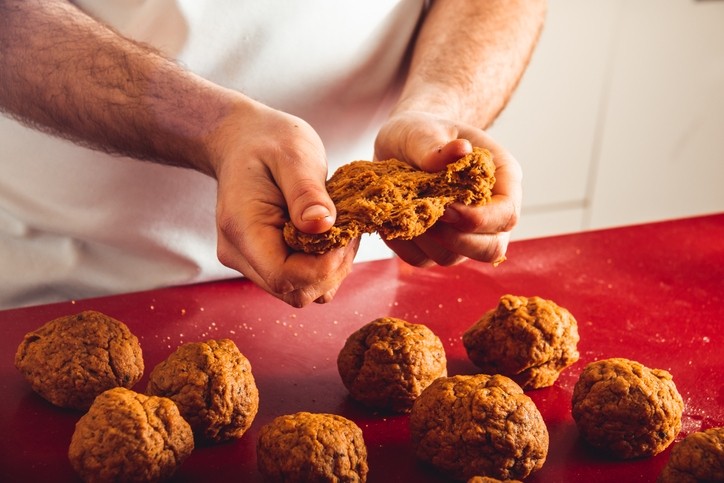Novel approach: Wheat gluten key to creating softer and less chewy texture in plant-based foods

Also known as meat analogues, meat substitutes or meat alternatives, they are typically made from plant-based ingredients such as wheat, soy, pea, peanut, lupin, and mung bean, designed to mimic the appearance, colour, texture, structure and nutritional content of real meat.
In this study, researchers in Singapore formulated four meat analogues by combining wheat gluten (WG) and soy protein isolate (SPI) in the ratios of 100:0, 80:20, 60:40 and 40:60% w/w dry protein basis), using the mechanical elongation method.
Meat analogues made with 100% WG showed the lowest hardness and chewiness.
Currently, there are no reports published on the development of meat analogues prepared using this method, and researchers have described it as a novel approach compared to the more traditional extrusion method.
“As much of the meat analogue process and manufacturing around the world use extrusion as a common processing tool, this study demonstrated the possibility of using the mechanical elongation method as a novel approach in developing meat analogues for the Asian and global market at a lower cost as compared to extrusion processing,” they wrote in Food Structure.
Therefore, this study represents the first attempt to use WG as a matrix for mechanical elongation for meat analogues.
Mechanical elongation method
To prepare the meat analogues, researchers first mixed WG and SPI according to the four formulations, and incubated it in the oven at 60°C for one hour to allow the gluten to be fully hydrated.
These ratios were selected on the basis of providing a complete range of essential amino acids. Despite this, due to the lack of lysine in WG, researchers added SPI to make up for this.
The meat analogues were then prepared with the mechanical elongation method.
The dough was first cut into smaller fragments using a food processor to stretch and pull, forming a secondary dough. The stretching and pulling is said to agglomerate the protein to form stronger networks.
The secondary doughs were then stretched to twice its initial length using a noodle maker, and folded to form final doughs.
Each dough was steamed in a food steamer for 1.5 h, reaching an internal temperature of 80°C, and stored in the refrigerator overnight at 4°C overnight before further analysis.
To serve as a baseline for comparison, the researchers also purchased commercially produced firm tofu, mock chicken and steamed chicken breast.
All samples were then analysed for protein content, moisture content, pH, amino acid composition, protein solubility, and textural properties.
Results
Among the four meat analogues, the one made with 100% WG exhibited the softest texture while the 40% WG (60% SPI) product showed brittle and dense structures when torn apart.
This was probably due to the presence of glutenins in WG which are responsible for the elastic behaviour, while SPI forms a firm, hard, resilient gel.
Meat analogues made with 100% WG also had significantly lowest (p < 0.05) moisture content among the four meat analogues. Researchers said WG is poorly soluble in water, which also meant the four meat analogues had significantly lower (p < 0.05) moisture contents than firm tofu, mock chicken and steamed chicken.
The meat analogues had moisture contents between 46.98 and 53.71 %.
The protein content of all four meat analogues increased with higher SPI concentrations, naturally since SPI contains more protein (85%), then WG (70%).
The protein content of meat analogues ranged from 32.07 to 36.21%.
The pH level of meat analogues also increased with higher SPI content, since SPI has a higher pH of 7.39, compared to WG’s 5.87.
The pH of meat analogues ranged from 6.59 to 7.10.
In terms of amino acid composition, the meat analogues contained between 21.22 to 23.71 mg/100 mg protein of essential amino acids (EAA), making it a good source of complete protein.
The predominant amino acids in the meat analogues were glutamic acid, proline, leucine and aspartic acid.
The total EAA for firm tofu and steamed chicken were similar to the meat analogues, while the total EAA for the mock chicken was comparatively lower.
These results suggest that the use of WG and WG-SPI produced acceptable doughs that could be used for the development of meat analogues using the mechanical elongation method.
“With increasing interests for meat analogues in Asia and around the world, the mechanical elongation method may serve as a low cost but highly applicable technology in an expanding consumers’ demand for palatable meat alternatives,” researchers added.
Novel approach
Most meat analogues manufacturers use the high-moisture extrusion process, however it can be an expensive process due to the high costs of equipment and energy required.
The high energy input required also negates some of the environmental benefits that are frequently associated with plant-based meat analogues.
The mechanical elongation method is a more affordable technique using less sophisticated equipment, as reported by Mattice and Marangoni (2021).
Since WG is already widely used in Asian foods, researchers believe WG is an appropriate substitute for zein in the development of meat analogues using the mechanical elongation method.
Source: Food Structure
https://doi.org/10.1016/j.foostr.2021.100183
“Physicochemical, textural and structural characteristics of wheat gluten-soy protein composited meat analogues prepared with the mechanical elongation method”
Authors: Jie Hong Chiang, et al.














